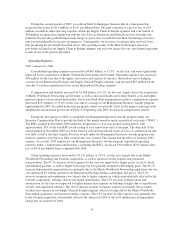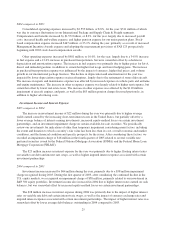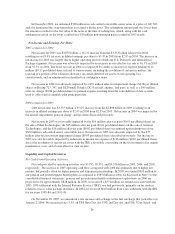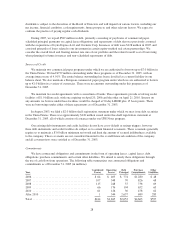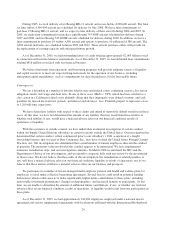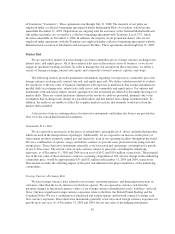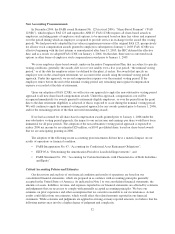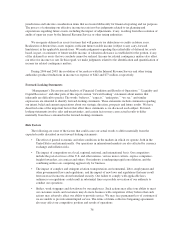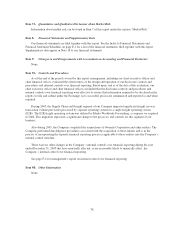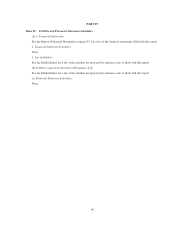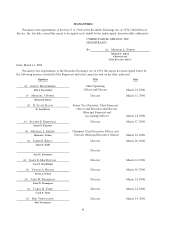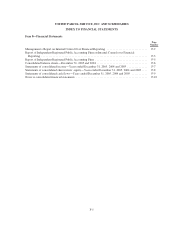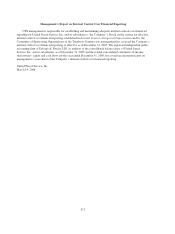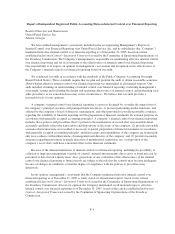UPS 2005 Annual Report Download - page 49
Download and view the complete annual report
Please find page 49 of the 2005 UPS annual report below. You can navigate through the pages in the report by either clicking on the pages listed below, or by using the keyword search tool below to find specific information within the annual report.
the claim remains open, trends in health care costs and the results of related litigation. Furthermore, claims may
emerge in future years for events that occurred in a prior year at a rate that differs from previous actuarial
projections. Changes in state legislation with respect to workers compensation can affect the adequacy of our
self-insurance accruals. All of these factors can result in revisions to prior actuarial projections and produce a
material difference between estimated and actual operating results.
We sponsor a number of health and welfare insurance plans for our employees. We use estimates from third
party actuaries to establish the liabilities for these plans. These liabilities and related expenses are based on
estimates of the number of employees and eligible dependents covered under the plans, anticipated medical usage
by participants and overall trends in medical costs and inflation. Actual results may differ from these estimates
and, therefore, produce a material difference between estimated and actual operating results.
Pension and Postretirement Medical Benefits—Our pension and other postretirement benefit costs are
calculated using various actuarial assumptions and methodologies as prescribed by Statement of Financial
Accounting Standards No. 87, “Employers’ Accounting for Pensions” and Statement of Financial Accounting
Standards No. 106, “Employers’ Accounting for Postretirement Benefits Other than Pensions.” These
assumptions include discount rates, health care cost trend rates, inflation, rate of compensation increases,
expected return on plan assets, mortality rates, and other factors. Actual results that differ from our assumptions
are accumulated and amortized over future periods and, therefore, generally affect our recognized expense and
recorded obligation in such future periods. We believe that the assumptions utilized in recording the obligations
under our plans are reasonable based on input from our outside actuaries and other advisors and information as to
historical experience and performance. Differences in actual experience or changes in assumptions may affect
our pension and other postretirement obligations and future expense. A 25 basis point change in the assumed
discount rate, expected return on assets, and health care cost trend rate for the pension and postretirement benefit
plans would result in the following increases (decreases) on the Company’s costs and obligations for the year
2005 (in millions):
25 Basis Point
Increase
25 Basis Point
Decrease
Pension Plans
Discount Rate:
Effect on net periodic benefit cost .......................... $ (54) $ 55
Effect on projected benefit obligation ....................... (548) 571
Return on Assets:
Effect on net periodic benefit cost .......................... (26) 26
Postretirement Medical Plans
Discount Rate:
Effect on net periodic benefit cost .......................... (5) 5
Effect on projected benefit obligation ....................... (77) 79
Health Care Cost Trend Rate:
Effect on net periodic benefit cost .......................... 3 (2)
Effect on projected benefit obligation ....................... 22 (14)
Financial Instruments—As discussed in Notes 2, 3, 8, and 16 to our consolidated financial statements, and
in the “Market Risk” section of this report, we hold and issue financial instruments that contain elements of
market risk. Certain of these financial instruments are required to be recorded at fair value. Fair values are based
on listed market prices, when such prices are available. To the extent that listed market prices are not available,
fair value is determined based on other relevant factors, including dealer price quotations. Certain financial
instruments, including over-the-counter derivative instruments, are valued using pricing models that consider,
among other factors, contractual and market prices, correlations, time value, credit spreads, and yield curve
34


